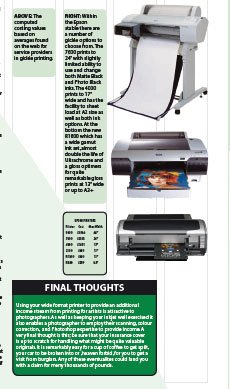articles/Fine-art/fineartrepro-page2
Fine Art Reproduction - part 2 of 1 2 3
by Mike McNamee Published 01/04/2005

The as scanned images on the left were also rendered to a neutral tone. The next part of the workflow to be improved was the scanning of large originals. Eight A4 scans is not an uncommon requirement and manual stitching usually takes at least an hour. It will be obvious that an A3 scanner, even though it requires a disproportionately higher investment, would still not cope with this size of original. We employed RealViz Stitcher to perform a flat stitch and provide a layered Photoshop file so that minor tweaks could be performed. Although Stitcher has earned its reputation on panoramas it is very efficient at making flat artwork stitches and only one very small adjustment was made to the final Photoshop file before flattening and final cropping. After final cropping a border was set up in Photoshop and titling added. The paper chosen for output was Permajet Artist Classic, the closest paper in terms of tone and tooth. Using an icc profile from the Permajet website, the image was printed at 1440dpi using Relative Colormetric rendering intent. The nominally A3 print was made in 4min 46seconds. The new 4000 printer delivers an average colour error of 7 Lab points straight from the box. This was improved to 5.0 points with bespoke profiling, specific to this machine.
The improvement in the more visually accurate DE2000 error was from 4.6 to 2.77 i.e. a 40% improvement. The slight residual yellow cast of the canned profile was totally eliminated by bespoke profiling. At this stage of the proofing, the artist and printer would normally discuss the print and seek ways of final tuning should any be required. This process may be an "enhancement" of the reproduction over the original. For example some people might prefer slightly more contrast or colour saturation and batter visual compromises might be made to out of gamut while the browns took on a pinkish glow. Called upon for advice, the writer soon persuaded Sinclair that an Epson 4000 was a significantly better investment than the 2100 both from the point of view of production speed and running cost. In addition the 4000 has the advantage of dual matte and photo black ink sets.

The advantages of the Epson Ultrachrome ink set are reduced metamerism (for a pigment), a higher gamut and a solid database of life testing. The Epson 2100 and 7600 also use the Ultrachrome ink set. However the change from one type of ink to the other (ie matte to photo black) is costly in flushed materials in the 7600/9600 machines and the ink is relatively more costly in the smaller 2100 cartridges, which hold 10 times less than those of the 220ml 4000/7600/9600 series. Artists are uncommonly sensitive to colour precision and a fully calibrated work flow is always going to pay dividends in improved efficiency towards obtaining a satisfactory proof. Sinclair Fine Art already uses a monitor calibrator. This checked out quite reasonably except that it was slightly low on gamma, the CRT was showing more shadow detail than the printer would deliver. The input is generally provided from an Epson 3170 flat bed scanner and this was profiled using the Nova Darkroom high accuracy IT8 Reflective Target using Monaco Profiler Pro. The as-scanne d IT8 target was about 4 points (Lab) magenta in the mid tone neutrals. This was corrected to perfect neutrality by the scanner profile (see images).
The as scanned images on the left were also rendered to a neutral tone. The next part of the workflow to be improved was the scanning of large originals. Eight A4 scans is not an uncommon requirement and manual stitching usually takes at least an hour. It will be obvious that an A3 scanner, even though it requires a disproportionately higher investment, would still not cope with this size of original. We employed RealViz Stitcher to perform a flat stitch and provide a layered Photoshop file so that minor tweaks could be performed. Although Stitcher has earned its reputation on panoramas it is very efficient at making flat artwork stitches and only one very small adjustment was made to the final Photoshop file before flattening and final cropping. After final cropping a border was set up in Photoshop and titling added. The paper chosen for output was Permajet Artist Classic, the closest paper in terms of tone and tooth. Using an icc profile from the Permajet website, the image was printed at 1440dpi using Relative Colormetric rendering intent. The nominally A3 print was made in 4min 46seconds. The new 4000 printer delivers an average colour error of 7 Lab points straight from the box. This was improved to 5.0 points with bespoke profiling, specific to this machine. The improvement in the more visually accurate DE2000 error was from 4.6 to 2.77 i.e. a 40% improvement.
Please Note:
There is more than one page for this Article.
You are currently on page 2 Contact Mike McNamee
1st Published 01/04/2005
last update 09/12/2022 14:54:17
More Fine-art Articles
There are 0 days to get ready for The Society of Photographers Convention and Trade Show at The Novotel London West, Hammersmith ...
which starts on Wednesday 14th January 2026





